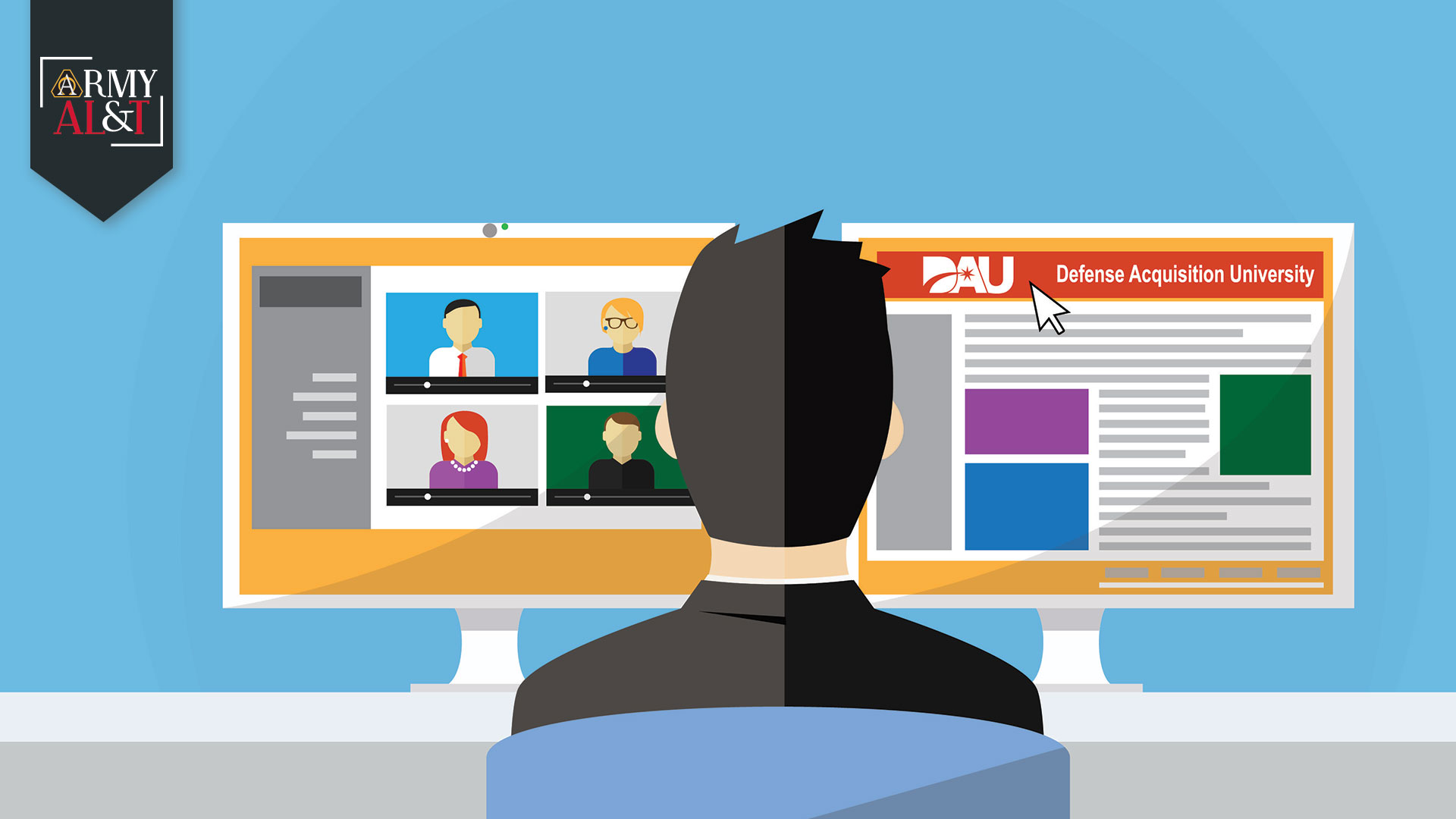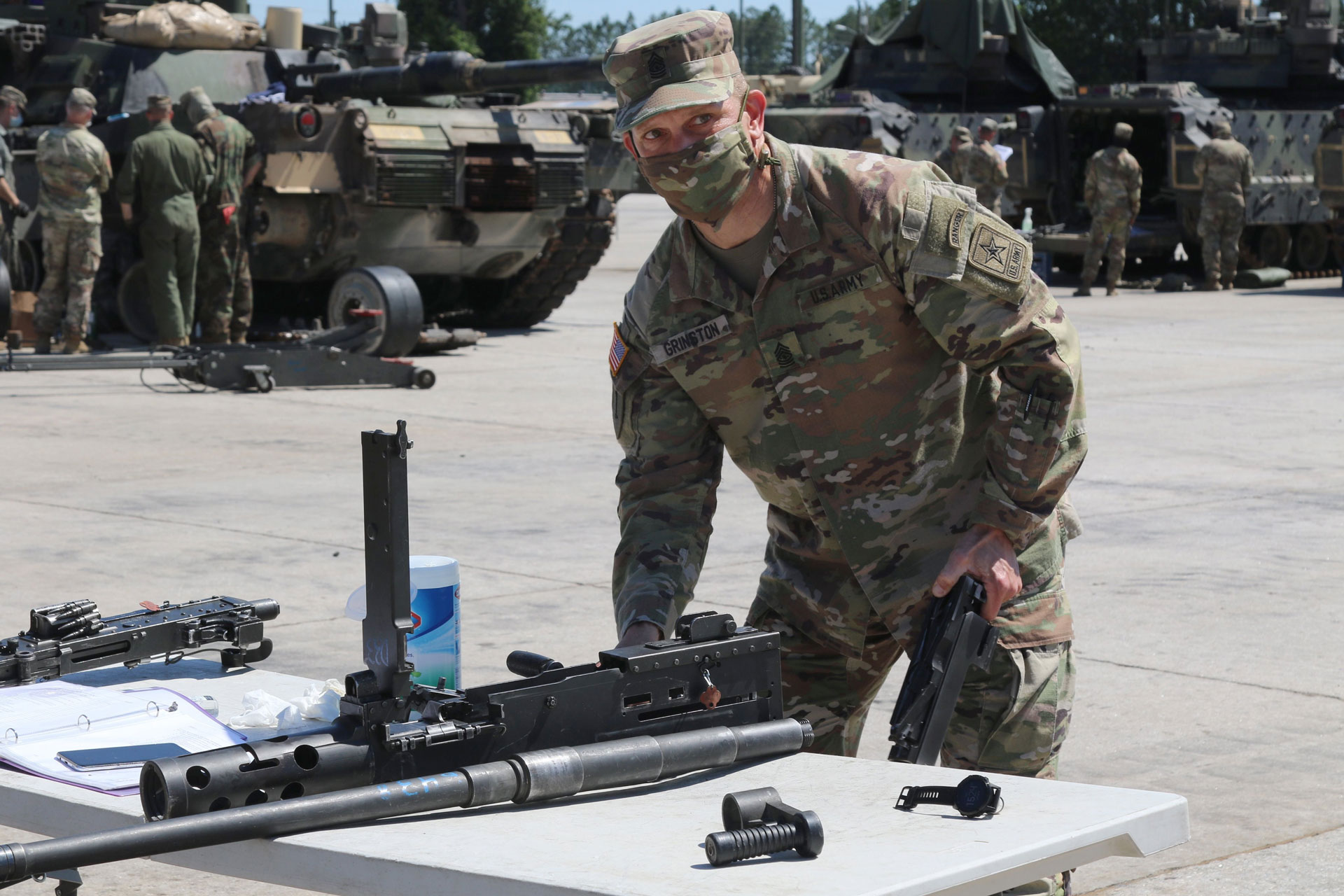
VIRTUAL LEARNING: Student-centered learning will help mitigate the challenges people have with distance learning. (Image by U.S. Army Acquisition Support Center)
The challenges of virtual education are many but can be overcome by putting the focus on the student.
by Jacqueline M. Hames
It’s only 10 a.m. and your house is a zoo—the first grader has to commandeer your computer to print an assignment, the sixth grader is attempting a presentation on Zoom and your spouse is on a conference call with the one person in the whole of the organization who never puts himself on mute.
Forget bandwidth issues, you need a referee.
These are the types of challenges many people face while working and educating at home—whether you’re educating yourself or members of your family. The situation varies in each household, of course, but everyone has faced challenges during the COVID-19 pandemic, be they interpersonal, educational or technological. So, what happens when you’re trying to further your career through training and education and you hit a stumbling block in virtual learning?
You focus on the student.

KEEPING A DISTANCE: Spc. Tyler Reninger, with the 301st Maneuver Enhancement Brigade, reviews course materials with his instructors and classmates during the emergency Basic Leader Course in Jordan. Because of the COVID-19 pandemic, junior enlisted Soldiers are continuing their professional military education through distance learning while travel restrictions are in place. (U.S. Army photo by Capt. Ernest Wang, Area Support Group – Jordan)
THE SHIFT
“The sudden onset of the COVID-19 pandemic in the United States immediately impacted the way most of us live our lives and conduct business,” said Susan Clark, Defense Acquisition University (DAU) team lead and acquisition training development manager with the Office of the Army Director, Army Career Management (DACM). “The national mitigation strategy called on all entities within the United States to practice social distancing and look at other ways to deliver goods and services. Schools and colleges were closed, and students, teachers and parents had to quickly learn how to study and teach virtually. The Defense Acquisition University is no exception.”
Thousands of students who were enrolled in resident classes at the time social distancing restrictions were put in place had to reschedule travel plans and return to their permanent duty stations immediately. Other students were temporarily stranded—but once DAU addressed the needs of students currently in training, they could focus efforts on future classes, Clark explained.
“DAU has reviewed their class schedule one week at a time to determine which classes could be delivered virtually and which classes would need to be canceled,” she said. “Transition from resident [classroom] training to virtual instructor-led training [VILT] has been well received, but the VILT offering has not been without challenges.”
Some students prefer hands-on, in-classroom training because it helps them learn better. Others find they have too many distractions in the home, from children needing help with schoolwork to spouses also working from home, Clark added. Then there are the technological challenges, like low bandwidth or issues using WebEx, which is DAU’s virtual learning platform. Finally, there may be scheduling conflicts—resident classes may have been rescheduled virtually at new times and previously enrolled students may not be able to attend anymore. Despite the challenges, Clark said the lessons learned during the pandemic have been beneficial.
“These new challenges provide DAU instructors with experience and knowledge to create new, pandemic response case studies which have been integrated into DAU course content,” Clark said. “VILT requires no travel and as a result, the government has saved hundreds of thousands of temporary duty travel dollars.”
Most importantly, DAU’s virtual classes gave students the means to meet their certification requirements as planned, she said.
FUTURE VIRTUAL EDUCATION
The COVID-19 pandemic has given the Army the opportunity to reassess how its trains its workforce, but the unique challenges of distance learning still need to be addressed. As Clark mentioned, some students prefer the resident experience because it provides more focus and interaction. And Soldiers will always need resident military education and training of some kind because their experience isn’t purely academic.
However, the future of Army education could shift to a more virtual experience—so how do we do that?
With student-centered learning, said John Dillard, senior lecturer for systems engineering at the Naval Postgraduate School’s (NPS) Graduate School of Engineering and Applied Sciences.
Dillard has been teaching at NPS since 1994 and has run the DAU equivalency program at NPS for about 22 years. NPS was already well prepared for the shift to 100 percent distance learning when the pandemic hit, as they had been practicing that mode of education for a long time. “We’ve been conducting distance learning for over 20 years,” Dillard said. “We started out with VTC—you needed a phone line and had to herd all the students into a conference room. It suffered from low bandwidth and frequent disconnections, but we still had confidence that live, synchronous, distributed education could work if we could maintain vigorous dialogue as a component.”
The distance learning courses at NPS have always been faculty-led and calendar-paced courses, which allows for more live interaction with the students and keeps them on track, Dillard said. Nowadays, using applications like Zoom and Microsoft Teams, Dillard and his colleagues can execute synchronous education—teaching in real time—as well as using asynchronous courses, “flipping the classroom” with recorded lectures and independent readings. But Dillard has recognized the same challenges at NPS that DAU is experiencing with distance learning—distraction, obstacles to engaging the material and technology issues. He believes the student-centered learning approach will help mitigate those issues.
Student-centered learning puts the onus on the students, Dillard explained. They must take the content that is hand-picked for them by professors, consume and analyze it, and then connect that material with other readings, and synthesize answers to the “so what” questions. Professors have to think a little outside of the box for this to work, posing questions in a “cagier way to elicit critical thinking,” he said. Dillard also recommends professors construct class sessions to be as organized as possible, providing specific due dates to keep students on track with their lessons and projects, and using the available technology in innovative ways to keep students engaged.
“This idea of student-centered learning, I think, is really powerful,” he said. There will likely be some multitasking (like checking text messages and email) occurring in a distance learning environment, just as in a resident environment, and there can always be other distractions, Dillard added. That’s why educators must require periodic deliverables. “Written essays, well-constructed exams and oral presentations seem to be a good means of ensuring engagement,” he said.

A NEW TWIST ON TRAINING: Sgt. Maj. of the Army Michael A. Grinston oversees 3rd Infantry Division Soldiers training with safety measures in place, such as the use of masks and physical distancing, at Fort Stewart, Georgia in May. (Photo by Defense Media Activity – Army)
CONCLUSION
Civilian learners aren’t the only ones who’ve had to make the transition to the virtual classroom. Both the U.S. Military Academy at West Point and the U.S. Army War College have gone online, Sgt. Maj. of the Army Michael A. Grinston said during an April virtual town hall at the Pentagon. The U.S. Army Sergeants Major Academy has also moved to virtual schooling using Blackboard, he said.
“We have actually suspended the select, train and promote policy for SLC and ALC, the advanced leaders course and the senior leaders course, so those sergeants that are eligible and in good standing with all the qualifications and meet the cutoff score, they will be promoted to staff sergeant, and those staff sergeants that are eligible and need to be promoted, they will get promoted to sergeant first class,” Grinston said. Soldiers have two ways to make up the professional military education requirement—apply for an exception, or go back and do the school later, he explained.
Recruiting, promotion boards and reenlistments continue virtually, as well. “We’re just finding great and creative ways to do this. I agree with the chief [of staff of the Army]. This is going to show what we can do in the future if we have to,” Grinston said.
“I have no doubt we’ll want to go back to brick and mortar soon as we can,” Dillard said when asked about the transition back to “normal” once the crisis is over. But he thinks some paradigms will shift and distance learning opportunities will continue to expand. People will be forced to question whether they need to be physically present in the office or the classroom to accomplish things. “We like the idea that our students don’t have to be in the same room with us to learn,” he said.
DAU is on board with continuing distance learning as well. “It’s unknown what future DAU class schedules will look like, but this pandemic has proven that some of DAU’s course content can effectively be delivered virtually. It should only be expected that VILT will be a permanent and more prominent course delivery method in future class schedules,” Clark said.
For more information, contact the author at jacqueline.m.hames.civ@mail.mil.
JACQUELINE M. HAMES is an editor with Army AL&T magazine. She holds a B.A. in creative writing from Christopher Newport University. She has more than 10 years of experience writing and editing news and feature articles for publication.
Read the full article in the Summer 2020 issue of Army AL&T magazine.
Subscribe to Army AL&T News – the premier online news source for the Army Acquisition Workforce. ![]() Subscribe
Subscribe







